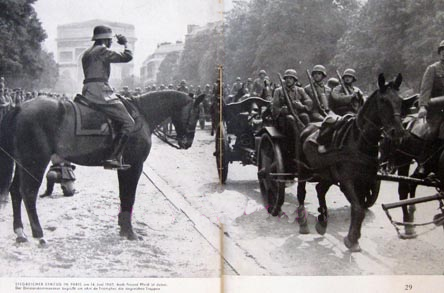German war history is frequently told incorrectly, obscuring huge waste and a lack of mechanization related to Nazi incompetence. A history book “Mechanized Juggernaut Or Military Anachronism“, for example, is described by its publisher as “myth-busting”:
One of the great misconceptions about World War II is the notion that the German Army was a marvel of mechanical efficiency… 75 percent of the German Army relied on horses for transport. Horses played a role in every German campaign, from the blitzkrieg in Poland in 1939 and the invasion of Russia to France in 1944.
Where does the myth come from? Most of it is an attempt to overlook slavery as inherent to Nazi planning — myth of a machine gets used as a metaphor for power to obscure reality, as if the Nazi regime wasn’t entirely dependent on massive human and animal suffering. A good framing can be found in a post called “Hitler’s Army Was Powered by Horses?”
Germany… was very under-mechanized but had a vast army, which meant it was dependent on horse-power and foot-slogging infantrymen. As a result of so many German men at the front, their factories were manned by slaves and POWs, who were underfed and treated abominably, and whose production capacity was affected as a result.
Germany could neither fuel its vehicles nor make enough vehicles to fuel, with the fuel it didn’t have anyway.

To be fair, the “myth-busting” material goes all the way back to WWII itself. An “Intelligence Bulletin, March 1946” put it rather plainly:
…the notion of the mechanized might of the German Wehrmacht was largely a glamorized myth born in the fertile brains of newspapermen. Actually, the lowly horse played a most important part in enabling the German Army to move about Europe. Public opinion to the contrary, so great was the dependence of the Nazi Blitzkrieg upon the horse that the numerical strength of German Army horses maintained during the entire war period averaged around 1,100,000. Of the 322 German Army and SS divisions extant in November 1943, only 52 were armored or motorized. Of the November 1944 total of 264 combat divisions, only 42 were armored or motorized. The great bulk of the German combat strength—the old-type infantry divisions—marched into battle on foot, with their weapons and supply trains propelled almost entirely by four-legged horsepower.
80% un-motorized in 1943…their weapons and supply trains propelled almost entirely by four-legged horsepower.
It begs the question why anyone is still surprised today to find out that the mechanized Nazi was just a “glamorized myth born in the fertile brains of newspapermen“.
Germans under Nazism increasingly sat in desperate conditions of the least modern army of WWII, mostly outmatched (their war basically lost by 1942), yet they stupidly continued fighting, as explained in 1957 by Dr. Curt Richter while studying animals.
During the war a considerable number of unaccountable deaths were reported among soldiers in the armed forces in this country. […] …apparently [people] die as a result of the belief in their doom.
Richter found that wild rats died after just 15 minutes after being put in water yet “domesticated” ones kept swimming for up to 60 hours.
That’s a six zero next to hours.
The research found eventually that repeatedly pulling the wild rats out of the water, then putting them back in, reliably increased their survival from just 15 minutes to the same incredible effort level of domesticated ones.
It was the “pulling” effect that gave rats motivation to continue, based on manufactured hope within the hopeless situation.
A more accurate telling of the German soldier’s situation in WWII, such as the obvious lack of mechanization, might prompt people to ask what really was “pulling” Nazis to continue on fraudulent marches of mass suffering (Hint: disinformation such as hate speech spread on radios).
People today idolizing or otherwise espousing false narratives about mechanization or modernity of Nazi Germany might just be a warning signal for disinformation analysts.
Update November 2022:
“Mars Technocracy” is one obvious example of modern-day Nazi disinformation that is meant just like 1930s campaigns to “pull” people into doom extremism.

The related “88” reference below is a well known symbol for “Heil Hitler“, illustrating how “Mars Technocracy” is used as an encoded phrase for white police state on Earth.

Related:
Security analysis of AI indicates “Tesla more likely to run over Black people”.
Perhaps the myth of the mechanized army was used to hide this reality and create the illusion of power. More of these materials will help us better understand the past and fight disinformation. Thanks for sharing.